City Trip Rome & Florence
Squares with churches and fountains everywhere
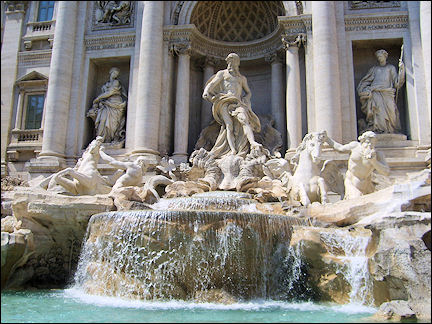
|
Of course there are remains from the Roman Era: the Colosseum, Forum Romanum and Palatine, but Baroque is the dominant style in Rome. Florence, which is easily reached by train from Rome, is a Renaissance city with many palaces. What both Italian cities have in common is the multitude of squares with churches and beautiful fountains. In Rome there are often obelisks as well. Both cities also have plenty of outdoor cafés.
Travelogue & photos: Angélique Woudenberg
At the airport Leonardo da Vinci, aka Fiumicino, we take the Leonardo Express train to Rome Termini station. On our way we pass suburbs with high apartment buildings, alternated with groups of planted cypresses. And then we arrive in Rome, the Eternal City on seven hills at both sides the Tiber river.
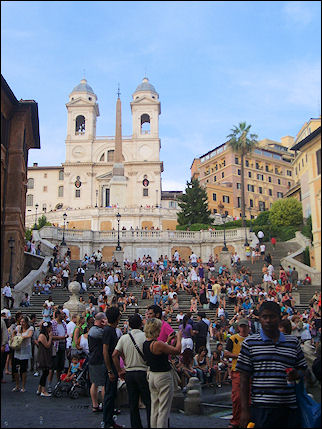
|
It takes half an hour and then we are in the busy and lively train terminal Termini. It is both a regional and an international train station: there are trains to Milan, Venice, Naples and Florence, but also high-speed international trains like the Eurostar. There are lots of shops and restaurants in and around the train station.
Our hotel is only a few minutes from the station. After checking in and taking a shower, we go to a Tabacchi (tobacco shop) to buy tickets for public transportation: a Biglietto Integrato a Tempo (BIT). Each ticket is valid for 75 minutes.
There are only two subway lines in Rome: the orange line (A) and the blue line (B). We take the orange line to Battistini and get off at the Spagna station. The subway is clean and, just like in Lisbon and Barcelona, there are homeless people begging, with or without a child.
Piazza di Spagna and Spanish Stairs
A spot to watch people and/or be seen
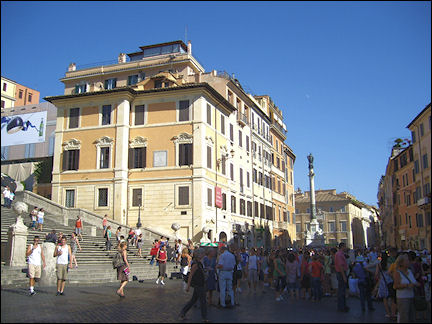
|
Once we have left the station, we follow the crowd to Piazza de Spagna, a small square with palmtrees, masses of tourists, horse-drawn carriages and a fountain. The square is surrounded by high buildings with shutters in ochre, rust, white and pink.
Opposite the fountain are the Spanish Stairs, the spot to watch people or to be seen. The stairs are filled to capacity. The Spanish Stairs were built in the eighteenth century to connect the French church Triniti dei Montei, at the top of the stairs, with the city.
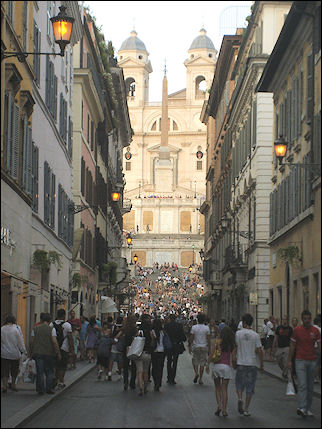
|
We sit down on the stairs to watch people. Two tourists next to us take a bottle of cola from their luggage and are immediately told to put it back by some guy. It is forbidden to eat or drink on the Spanish Stairs and if you do, you risk a fine.
On Piazza di Spagna are tour guides with large signs that say Rome Free Tour. Every day at 5 PM free walking tours with an official tour guide leave from here. We approach a guide and each get a red sticker with two footprints on them. In the company of English, Spanish, French and Dutch tourists we follow the enthousiastic guide.
It is a one and a half hours walk, which starts at Piazza di Spagna and ends at Piazza Navona.
The guide welcomes us to Roma, as the Italians call Rome. The people who live in the city call themselves Romans.
Opposite the Spanish Stairs (138 steps) is the Barcaccia fountain, designed by Bernini. This famous sculpturer was portrayed by Dan Brown in The Bernini Mystery. Bernini lived in the seventeenth century and was popular with the popes. He designed many fountains and statues for churches and squares in Rome.
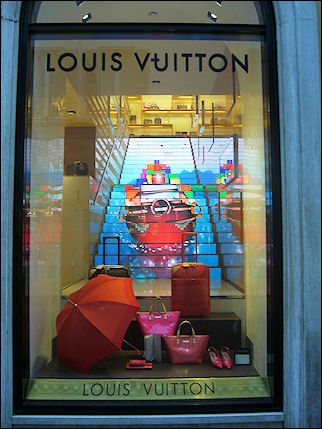
|
The guide tells us that many buildings in Rome were built in Baroque style.
Piazza di Spagna was already popular with visitors in the 19th century. From that period is the old English teahouse Babington's Tea Rooms, which still is a tearoom.
To the right of the Spanish Stairs, on a corner, is the Keats-Shelley Museum. The guide tells us that the English poet Keats stayed in this house in the 19th century to recover from tuberculosis.
After Keats and his friend and colleague Shelley died, the house became a museum and library with the name Keats-Shelley Memorial House.
Opposite the Barcaccia fountain, in a side street off Piazza di Spagna, is the shopping street Via dei Condotti. It has brand stores with clothes from Armani, Gucci, Prada and Louis Vuitton. Here you also have a view of the Triniti dei Montei and the obelisk at the top of the Spanish Stairs.
Fontana di Trevi
Pushing and shoving to throw a coin over your shoulder
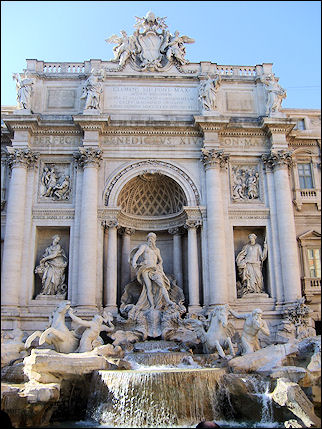
|
We walk through narrow alleys, along countless restaurants, outdoor cafés and drinking fountains with cold water, to the Fontana di Trevi. Rome has many squares (piazzas), obelisks and fountains. But the Trevi is the most famous fountain in Rome.
The fountain is gigantic and so is the crowd that surrounds it. It's literally push and shove to get a place near the fountain. It was built in Baroque style and figures in a famous scene in La Dolce Vita, in which actress Anita Ekberg walks in the Trevi fountain.
Look, says the guide, if you turn your back to the fountain and then throw a coin over your left shoulder with your right hand, you will return to Rome at some time in the future.
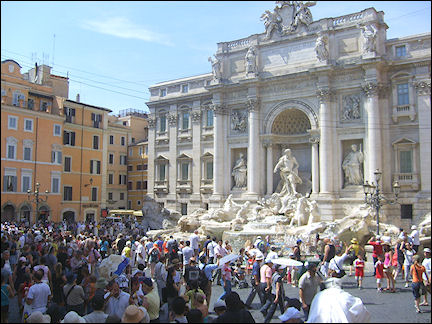
|
Eventually we succeed in turning our backs to the fountain and throw in the coins. Next to us is a homeless person with a hand net. He unabashedly scoops up our coins as soon as they have fallen in the fountain. Part of the money goes to the Italian Red Cross and the rest is for the City of Rome.
Pantheon
The dome symbolizes the universe
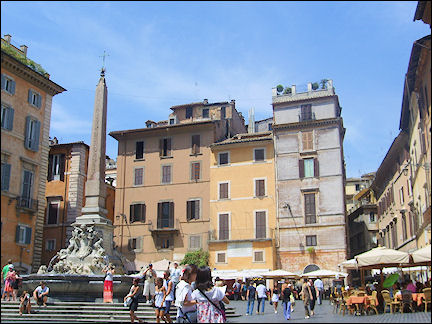
|
We continue on our walking tour towards the Pantheon on Piazza della Rotonda. The square is surrounded by restaurants and outdoor cafés, and at the center of the square is another obelisk, a fountain and a drinking fountain. It's clear that this is tourist season: streets, alleys and squares are overflowing with tourists.
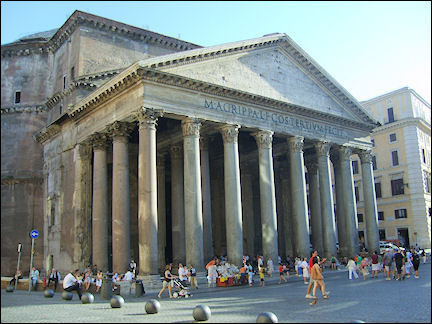
|
The Pantheon was an ancient Roman temple, dedicated to all their gods. On the outside is a colonnade. Over the ancient temple, on the timpanon, the first name is M. Agrippa.
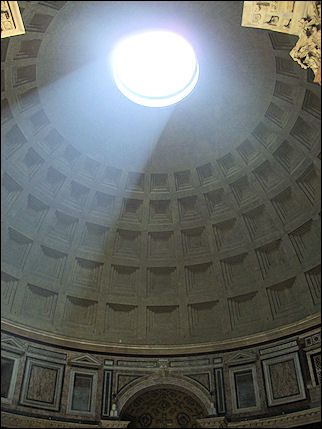
|
Marcus Agrippa built the original temple in 27 B.C. After it was destroyed in a fire, Hadrian commissioned the Pantheon to be rebuilt on top of the old temple.
The guide tells us there are several tombs inside the Pantheon, among others the graves of the artist Raphael (Raffaëlo Sanzio). Raphael, a famous painter, also painted the murals on ceilings and walls of the Vatican Palace. Several Italian kings are also buried in the Pantheon.
In the Middle Ages the Pantheon became a church. Unfortunately a ceremony of some kind is going on when we arrive, so we can't go inside. We'll do that later this week. Then we will see that its dome is wonderful indeed. The dome symbolizes the universe and has the shape of a perfect sphere, with a diameter of 43.3 meters.
Piazza Navona
Three fountains, an obelisk and Saint'Agnese in Agone
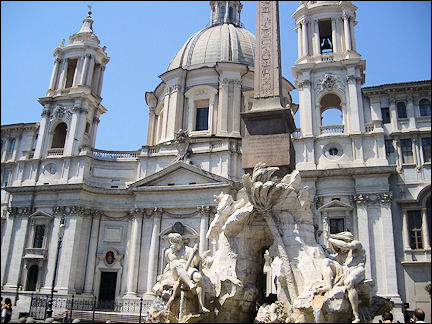
|
We walk on to Piazza Navona, a lively pedestrian square with three fountains, an obelisk, a church (Saint'Agnese in Agone), living statues, artists, musicians and many, many outdoor cafés.
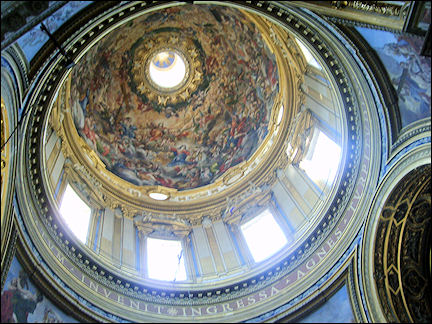
|
Saint'Agnese in Agone is, according to legend, built on the spot where Saint Agnes was shown naked because as a Christian she rejected a heathen. Her long hair completely covered her body, but she was killed. We think the beautifully decorated dome is the best part of this church.
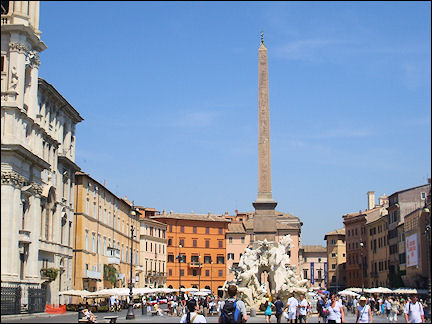
|
Piazza Navona owes its oval shape to the fact that is was built on the spot where the Domitian stadium once stood. It was used among other things for athletics.
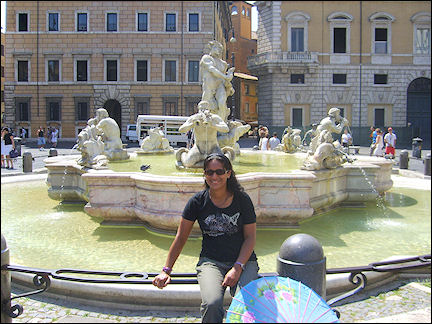
|
In the middle of the square, below the obelisk, is a large fountain designed by Bernini: Fontana dei Quattro Fiumi (Fountain of the Four Rivers). This river symbolizes four rivers: Ganges, Nile, Danube and Rio de la Plata.
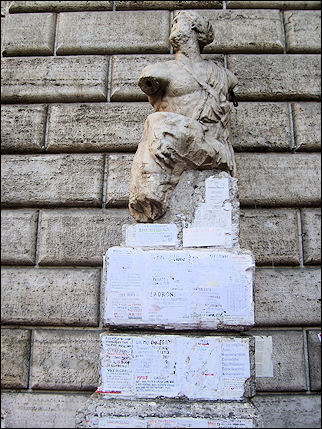
|
In front of the Fontana del Moro, also on Piazza Navona, are several living statues, who move when you throw money in their bowls. Almost all fountains we have seen so far are decorated with nude statues.
The guide takes us to a statue behind Piazza Navona, Pasquino. This statue stands for freedom of speech. At its feet we see scraps of paper attached to its pedestal, with texts, protests and slogans in Italian. This is also the end of the interesting city walk. We thank our guide and give her a generous tip.
After the tour we have our first pizza here in one of the most expensive outdoor cafés on Piazza Navona; afterwards we take the bus back to Termini station.
Santa Maria Maggiore and Colosseum
50,000 spectators would watch the gladiators fight
After breakfast we walk to Santa Maria Maggiore, the church with the highest belltower in Rome.
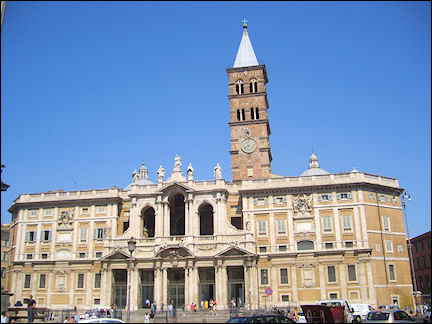
|
According to legend, Pope Liberius built this church after Maria ordered him in a dream to build a church on the spot where snow would fall that night. A miracle happened and the next morning there was snow in one place and the church was built.
Santa Maria Maggiore is the largest Maria church in Rome and is owned by the Vatican. There are several hop-on-hop-off buses in front of the church (they drive along almost all highlights). We take the red line and stay on the bus until its final stop: this way we get a good impression of the city center. We get our own audio players with headphones and hear about the history of Rome and the sights we pass.
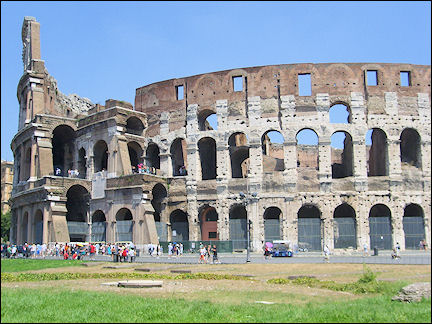
|
We get off at the Colosseum. Until the fifth century, this was the largest amphitheatre in the Roman Empire. Its construction was financed with the spoils of the looting of Jerusalem in 70 AD. Part of the Colosseum was torn down to use its stones for the construction of bridges, palaces and parts of St. Peter curch.
Hundreds of people are waiting in line: the waiting time is over two hours. It's better to get your ticket at the Palatine. Those tickets are valid for the Colosseum, Palatine and Forum Romanum.
Emperors and rich Roman citizens financed free performances for the people in the Colosseum. There was room to seat about 50,000 spectators, who would come to see gladiator fights. The audience could enter via one of eighty archs. In these barbaric fights between gladiators or with wild animals (lions and tigers) someone would always die. Around the Colusseum we see fake-gladiators who will have their pictures taken with you for money.
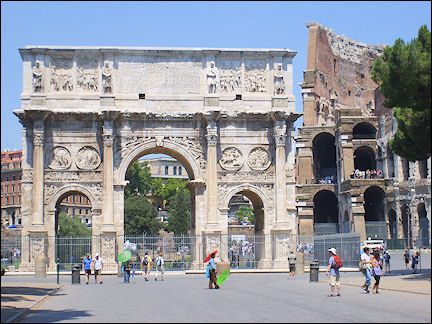
|
Next to the Colosseum we see the Arco di Constantino, a triumphal arch dedicated to Emperor Constantine. The arch is decorated with reliefs of military victories and other images. Many emperors commissioned triumphal archs to honor themselves.
Opposite the triumphal arch and the Colosseum we see Via Sacra, the sacred road. This was the main street in the center of ancient Rome. It was used for processions and victory parades. Soldiers and prisoners of war participated and the loots of war were shown. At the end of the parade, the leader of the enemy army was killed in public.
Forum Romanum and Palatine
Rome was founded on the Palatine hill
Forum Romanum was the political, commercial and religious heart of the ancient Roman empire. Here, the senate deliberated, speeches were given, and merchants did business. When the power of the Roman empire was in decline, the Forum fell into disrepair. But the remains of temples, triumphal archs and Constantine's Basilica are still there.
South of Forum Romanum is the Palatine, one of Rome's seven hills. Yesterday, our guide gave us a lecture about the birth of Rome. The mythical twins Romulus and Remus founded the city.
Their mother Rhea Silvia was pregnant by Mars, the god of war. She was killed and Romulus and Remus were thrown in the Tiber in a wicker basket. A she-wolf found them and raised them in a cave in the Palatine hill. This she-wolf is now the symbol of the city of Rome.
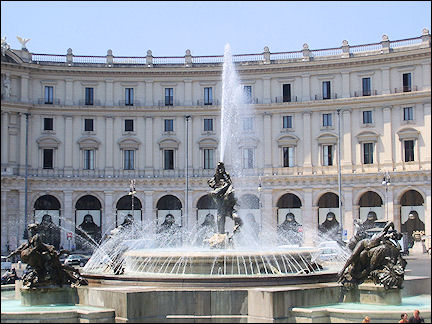
|
According to legend, Romulus killed his twin brother Remus in a fight over which one of them would rule over the city they founded on Palatine hill in 750 BC. So Romulus became the first king of Rome and lent the city his name.
The ruling class used to live on this hill and there are still remains of palaces, among other Emperor August's.
We get on the hop-on-hop-off bus to have dinner on Piazza della Repubblica and recover from the heat. In the middle of Piazza della Repubblica is the Fontana della Naiadi. At its center is the god of the sea, Neptune, surrounded by nude nymphs on water animals like seahorses and swans.
Campo de'Fiori
We hear the vendors in the marketplace from a great distance
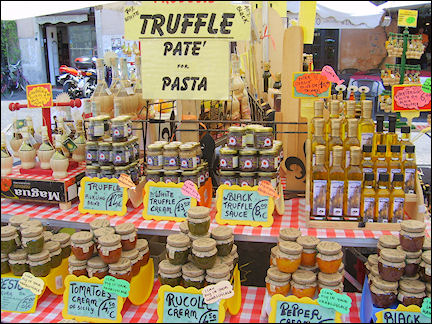
|
Immediately after breakfast we walk to Santa Maria Maggiore, where we take the blue line to Corso Vittorio. From there it's only a short walk to the market Campo de'Fiori.
We hear the vendors from a great distance advertise their goods. There are market stalls with vegetables, fruit, flowers and pasta. One stall has all kinds of herbs that we never even heard about.
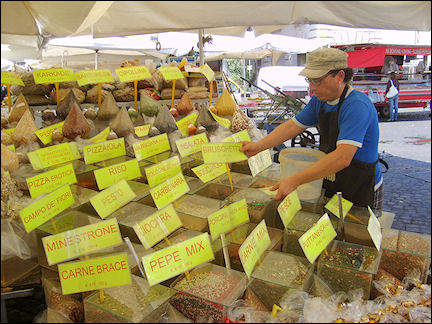
|
In side streets off Campo de'Fiori are several ice-cream parlors, pizzerias, trattorias, outdoor cafés and parking spaces for many, many scooters.
By the way: we notice that Vatican City is nearby because of the many nuns in the streets. At the market we spot two shopping nuns.
Vatican City
The smallest independent state in the world
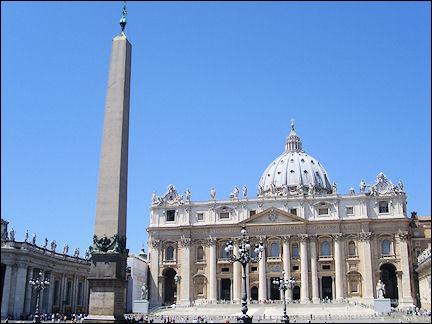
|
Vatican City, with its surface of only 0.44 square kilometer, is the smallest independent state in the world. On Saint Peter Square, also designed by Bernini, are the St. Peter Church, an obelisk and a colonnade. We expected long lines, but this many people...
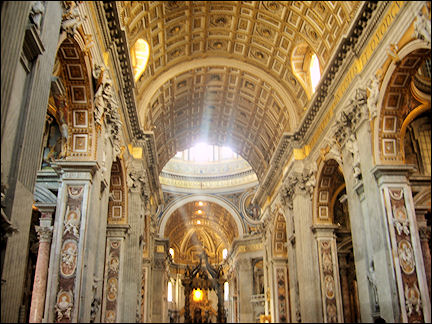
|
When we finally enter, we are overwhelmed by the pomp and circumstance. The interior is beautifully decorated. On the right side we see Michelangelo's Pietà. The marble sculpture, which represents Maria holding her dead son, is protected by bullet-free glass.
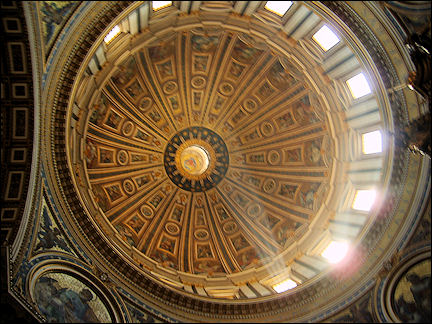
|
At the center of the St. Peter Church, below the dome - which was designed by Michelangelo - is Peter's tomb. Over his grave is the pontificial altar, which in its turn is framed by a bronze canopy designed by Bernini.
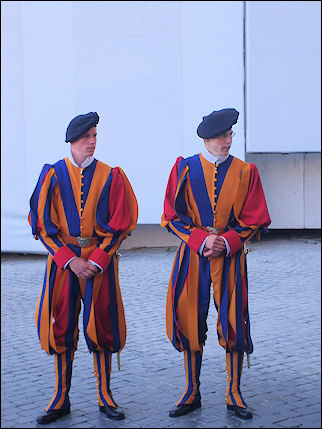
|
We see a list of all dead popes starting with Peter and ending with Pope John Paul II, who died in 2005.
The church is overwhelming enough that we take the rest of the afternoon to look around. The lines for the Sistine Chapel are incredibly long, so we will save that for our next visit.
Once outside we see two Swiss Guards guarding the church and the Vatican. They are dressed in colorful uniforms, which were designed by Michelangelo.
On St. Peter Square is also a post office where we mail our picture postcards. They are supposed to arrive faster than if you send them from Rome.
Excursion to Florence (Firenze)
Rich bankers invested their money in palaces
We get up early to catch the 6:35 AM train to Florence. The trip takes about three hours and leads us through tunnels in the foothills of the Apennine Mountains, deserted regions and beautiful landscapes. There also is a Eurostar service, which takes you to Florence in only one and a half hours, but this high-speed train is very expensive.
A little after 9:30 AM we arrrive at our destination in Florence: Santa Maria Novella. Because we made reservations for a 5:55 PM train back to Rome, and still want to see as much of Florence as we possible, we take the hop-on-hop-off bus which leaves a little after 10 AM.
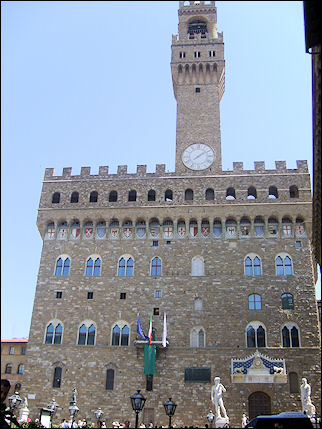
|
We first take the green line which stops at several highlights.
We pass the Santa Maria Novella church across the street from the train station Firenze S.M.N. and the impressive Duomo and then get a history lesson about Florence.
Florence, which lies on the banks of the Arno river, was Italy's capital from 1865 to 1871. Nowadays it is the capital of Toscane province. The city was founded as a Roman settlement. During the fifteenth and sixteenth centuries it was an important center of art and architecture, culture and politics, ruled by the De Medici family.
Rome's dominant architectural style is Baroque. Florence's heyday was during the Renaissance, and so most buildings are still in this beautiful style.
Rich bankers spent their money on beautiful palaces, on decorating churches and on commissions for artists like Michelangelo.
Fiesole
Etruscan and Roman remains
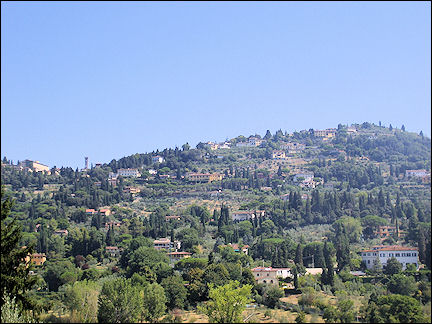
|
We drive through a suburb of Florence, over winding roads into the mountains to the town of Fiesole at about 8 kilometers north of Florence. We see cypresses, nice houses on hills and several camping sites where, judging from the license plates, many Dutch spend their vacations.
Fiesole has many Etruscan and Roman remains. It also has great views. We visit the large campanile of the Duomo and several ruins.
Ponte Vecchio
A 14th century bridge over the Arno
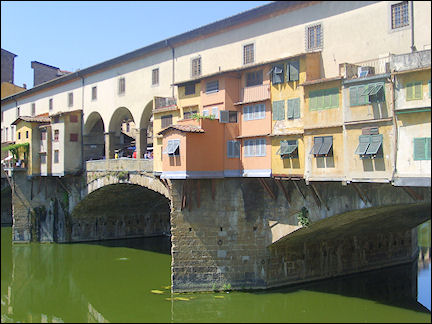
|
After this short visit we return to Florence, where we get off at the Ponte Vecchio. This 14th century bridge is the oldest in Florence.
Even though it's Sunday morning, the bridge is flooded with tourists who all want to take the same picture in the same spot. There are many jeweler's shops on the bridge, selling mostly gold jewelry.
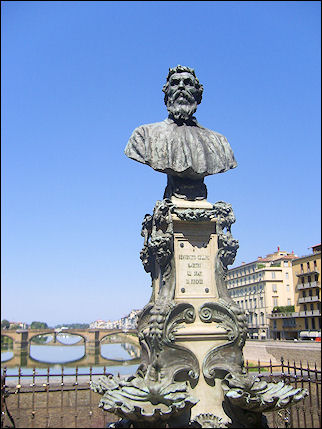
|
In the past there were butcher shops and smiths' workshops on the bridge, who would toss their garbage in the river. To end the nuisance of the stench, their places were taken by goldsmiths. In the middle of the Ponte Vecchio stands a statue of the famous goldsmith Cellini who had a workshop on the bridge in the sixteenth century.
There are also souvenir shops and pushy streetvendors on the bridge, who sell drawings of Ponte Vecchio, the Duomo and even Michael Jackson. If you look at the drawings for even a moment, they already roll them up for you, follow you and try to push them into your hands.
We walk along the Arno and then through a pedestrian colonnade to the Uffizi Museum where hundreds of people are waiting in line.
The Uffizi Museum was a gift to the people of Florence from the De Medici family. The museum has many works of art by Florentine Renaissance artists, like Leonardo Da Vinci and Michelangelo. In the outside colonnade we see sculptures by Michelangelo and other sculpturers.
Piazza della Signoria
Michelangelo's David is a copy
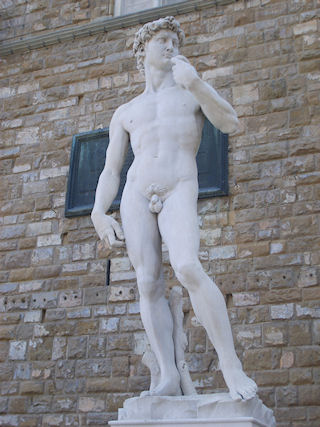
|
We arrive at the Piazza della Signoria, one of Florence's tourist squares. An advantage of this is that it is pedestrian. In hectic Rome we always have to watch out for speeding vespas and cars.
First we see Palazzo Vecchio (Old Palace) with in front of it Michelangelo's most famous sculpture, David. Next to it stands Bandinelli's statue of Hercules and Cacus. The David, who is about to attack the giant Goliath, is a copy. The original is in the Galleria dell'Academia.
Palazza Vecchio with its 90 meters high belltower now serves as a museum. It used to be the meeting hall for the leaders (signoria) of the main guilds, who ruled the city. We see their coats of arms at the foot of the campanile.
To the left of Palazza Vecchio is the Neptune fountain, which represents the Roman god of the sea surrounded by water nymphs.
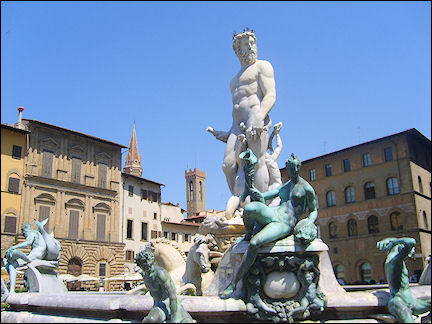
|
On Piazza della Signoria we see many more statues, among others in the Loggia dei Lanzi. The square is surrounded by outdoor cafés. We crash in one of these busy and expensive outdoor cafés with a view of Palazza Vecchio and strolling tourists.
Mercato Nuovo and the Duomo
The gigantic thirteenth century Duomo is the heart of the city
After lunch we walk to the Mercato Nuovo, with many, many souvenir stalls and then on, via Piazza della Republica and some shopping streets near it, to Piazza del Duomo. The gigantic thirteenth century Duomo Santa Maria del Fiore stands here. Together with the Baptistery and belltower it forms the heart of the city.
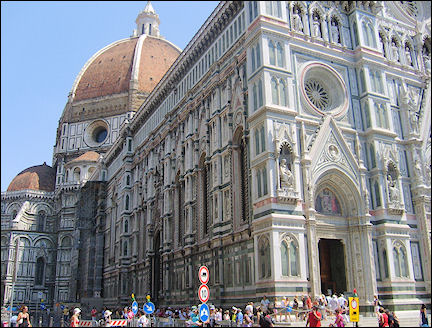
|
We walk around the Duomo and Baptistery, which has a nice golden door behind a barrier that keeps tourists at a distance. Michelangelo called this door the "gate of paradise".
It is only a few minutes walk from the Duomo to the train station. There we board the sightseeing bus' blue line.
Piazzale Michelangelo
A wonderful view of Florence
The blue line takes us along the San Marco Square, the Santa Croce cemetary where Michelangelo and Galilei are buried) and Palazzo Pitti. We cross the Arno river and get off the bus at Piazzale Michelangelo.
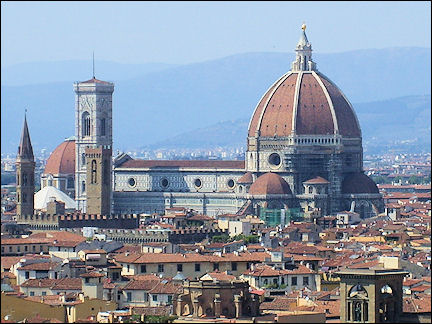
|
There we have a great view of Florence. The Duomo towers over the city. We can also see Ponte Vecchio and Palazzo Vecchio clearly.
We return to the train station where our train leaves for Rome at 5:55 PM.
Piazza del Popolo
Formerly the main entrance gate of Rome
After breakfast we take the subway to Cinecittà station to visit the shopping mall Cinecittà Due Cento Commerciale. It's August and the sales are in full swing. The shopping mall has 82 stores and is nice and cool. A relief, with these outside temperatures.
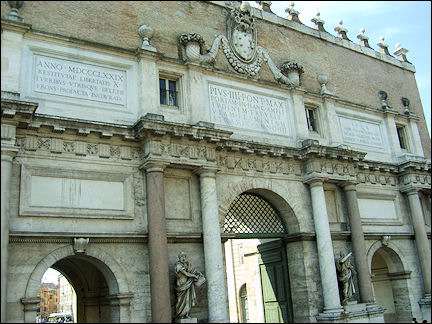
|
We take the subway back to Flaminio station to visit Piazza del Popolo. The large gate on the square used to be the main entrance gate of Rome. It has a Roman arch and on both sides are statues. Immediately behind the gate is the Santa Maria del Popolo church.
Piazza del Popolo is as it were the meeting point of three streets: Via del Corso, Via del Babuino and Via di Ripetta. Because of this it is also called the Trident. As on other squares in Rome, there are a fountain, an obelisk and a church (in this case more than one).
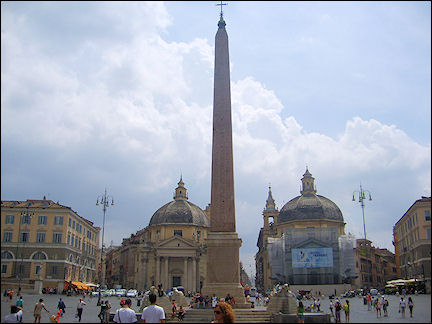
|
The Egyptian obelisk Flaminio has hieroglyphs. This obelisk was looted by Emperor August's army after the conquest of Egypt in the year 13 AD. Behind it are two almost identical churches: Santa Maria dei Miracoli and Santa Maria in Montesanto. The only difference is that one has a round dome and the other an oval one.
The square has a laid-back atmosphere, but in the 18th and 19th centuries people were sentenced to death and executed here..
We take the bus to Termini station. On Piazza della Republica we have something to eat and drink in an outdoor café and then it's really time to get our luggage and go to the airport. We threw several coins in the Trevi fountain, so we will certainly be back here.